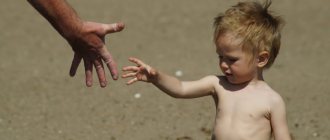Why do children worry?
Anxiety can also be observed in preschool children.
Anxiety - an increased tendency to fear and worry - can be situational and constant . If in the first case anxiety is justified, since it helps to avoid any dangerous situation, then the anxiety that accompanies a person often and for no reason turns into a problem.
Anxiety can also occur in preschool children.
A child with increased anxiety is different:
- constant depression
- wariness
- difficulty in establishing contacts
- hostile perception towards the world
- a gloomy view of the surroundings
- low self-esteem.
Increased levels of anxiety in young children may occur due to:
- Hereditary characteristics of the nervous system and character.
- Birth injuries, infections and other diseases suffered at an early age.
- Illnesses suffered by the mother during pregnancy.
- Damages to the nervous system of the fetus and child before, during and after childbirth.
- External circumstances (overprotection, parental rejection, etc.).
Among the causes of increased anxiety in preschool children are:
- Uncontrolled TV watching. According to psychologists and psychotherapists, young children are most often afraid of some frightening cartoon character.
- Severe fear (meeting with an animal, attack by a villain, accident on the water, fire or flood, military action, etc.). Having experienced this, preschoolers may behave inappropriately.
- Unfavorable atmosphere in the family (quarrels, screaming, conflicts, etc.). Children from such families may experience psychosomatic symptoms (rapid heartbeat, breathing problems, etc.), leading to various kinds of diseases.
"Good to know. A tense socio-psychological climate in the family gives rise to increased anxiety in the child. Children who feel unloved grow up to be anxious, restless, and insecure.”
- Unfriendly atmosphere in the preschool educational institution. Sometimes the cause of children's anxiety can be the behavior of the kindergarten teacher: threats, punishments, etc. A child who constantly hears screaming cannot develop normally, since his nervous system is under tension, which manifests itself in emotional imbalance.
- Peer ridicule. Kids feel humiliated if their peers manage to make fun of them.
- Anxious behavior in adults. Children take their cues from how their close adults behave.
- The demands of adults are too high, which the child is unable to fulfill.
- Authoritarianism of parents. The power of parents breeds fear.
- Differences in views on upbringing in the family. It is difficult to comply when one parent prohibits and the other allows. Then there is a concern that one of the parents will not approve of the behavior or any action.
- Expecting trouble. Children are afraid of their parents when they know that nothing good can be expected from them (in cases of drunkenness, attacks of cruelty, or even just a bad mood of adults).
Features of increased anxiety in younger and older preschoolers
The anxiety of older preschoolers may be associated with errors in family upbringing and the atmosphere at home, and gradual preparation for the start of school.
As already mentioned, anxiety can occur in different age groups of children.
In newborns, this symptom manifests itself in the form of increased anxiety, tearfulness, poor sleep and appetite.
Anxiety in children of primary preschool age is associated with the crisis of 3 years. The baby begins to go to kindergarten, and therefore experiences anxiety due to separation from his mother and adaptation to new social conditions.
The anxiety of older preschoolers may be associated with errors in family upbringing and the atmosphere at home, and gradual preparation for the start of school. Older preschoolers worry no less than younger ones about whether their parents will come to pick them up and whether everything is okay with them. Children with low self-esteem suffer from increased anxiety: their experiences are associated with communication with peers and the roles they play in the group.
With increased anxiety in preschool children, the following may occur:
- neuroses
- obsessive thoughts and movements
- phobias.
A high level of situational anxiety may be preceded by situations of possible separation from the mother, separation from parents, or a sharp change in the usual environment.
Increased anxiety in such children can manifest itself as follows:
- In behavioral reactions:
- the child may constantly twist and fiddle with something in his hands (paper, clothes, hair), bite his nails and pencils, suck his fingers
- excessive stiffness and tension
- increased fussiness, gesticulation
- a child may constantly drop and lose something
- the baby gets lost when asked questions, gets confused and lost when he tries to say something
- tearfulness.
- In physiological reactions and symptoms:
- redness or, conversely, paleness of the face
- excessive sweating
- hand trembling
- flinching at unexpected sounds
- rapid heartbeat, difficulty breathing, complaints of abdominal pain and headache, urge to urinate
- sleep disorders
- problems with appetite.
- In experiences and feelings:
- fear of failure
- the burden of waiting
- desire to leave
- feelings of insecurity
- feeling of inferiority
- feeling of shame or guilt.
“A high level of situational anxiety may be preceded by the possibility of separation from the mother, separation from parents, a sharp change in the usual environment, and much more.”
Causes of anxiety in children
Anxiety in children is caused by the following reasons:
- disturbances in relationships between children and adults;
- improper upbringing of children (parents often want and demand from their children what they cannot do: good grades, ideal behavior, showing leadership among children, winning competitions).
The excessive demands of parents on their offspring are often associated with personal dissatisfaction, as well as the desire to realize their own dreams in their child. Sometimes inflated demands are associated with other reasons, for example, one of the parents is a leader in life and has achieved material well-being or a high position, and does not want to see a “loser” in their child, making inflated demands on him.
Often, parents themselves have increased anxiety and their behavior sets the baby up for anxiety. Often, parents, trying to protect their child from imaginary or all real threats, create in him a feeling of defenselessness and inferiority. All this does not affect the normal development of the baby and prevents him from fully opening up, causing anxiety and fear even in simple communication with adults and peers.
How is diagnosis carried out?
You can diagnose the level of anxiety in a preschooler by turning to the most famous technique - the Temple-Amen-Dorki test . The point of the test is to find out the child’s behavioral reactions to 14 proposed situations and those depicted in the pictures:
- A child playing with a younger child. Is he happy or sad at this time?
- The child walks with his mother pushing the baby in a stroller. Is the older child happy at this time or not?
- One child shows aggression towards another - he runs and swings at him.
- The child puts on his own socks and shoes. Does this activity give him positive emotions?
- A child plays with older children. Is he happy or sad at this time?
- Parents watch TV, and the child needs to sleep at this time. Joy or sadness?
- The child washes himself. What does his face look like when he washes his face?
- The child is scolded by his father or mother. What kind of face does the child have at this?
- Dad plays with the newborn and at this time does not pay attention to the older child. Is he happy or sad at this time?
- One child tries to take a toy from another. Is it a fun game or a conflict? Sad or happy?
- Mom makes the child collect the toys scattered around the room. How does the child feel?
- Peers leave the child. Is it sad or happy?
- Family portrait: child with parents. Does the child have a happy facial expression?
- The child has lunch alone. Is he sad or happy?
The child’s answers need to be entered into a table about what the child experiences regarding each statement - joy or sadness.
Methods for diagnosing and relieving anxiety and aggressiveness in preschool children
Methods for diagnosing and relieving anxiety and aggressiveness in preschool children.
(a manual for teachers and parents).
One of the most interesting methods for identifying and relieving aggression and anxiety in children is the “Fairy Tale” test, compiled by the famous child psychologist Louise Duss. In the fairy tales she suggested, there is a character who has to make a choice. The child will try to identify himself with him. Depending on his state, he will react to the situation described in the fairy tale, calmly or anxiously, and the state that he wants to attribute to the action of the fairy tale will remain in the child. All fairy tales end with a question, the answer to which must be given by the child.
The purpose of this test is to find out whether emotions will spontaneously arise that are usually not manifested in the child’s behavior, but at the same time live in him.
This test is especially suitable for use in families because it does not require special testing conditions. However, there is some creativity required to achieve the desired result.
First, the child must feel that the test is a game like everyone else. To do this, you need to choose a convenient moment or make sure that the child himself asks to tell a fairy tale.
Secondly, you should never comment on the child’s answers and rush, saying: “Now listen to another fairy tale.”
Thirdly, if the child shows anxiety or excessive excitability while listening to the story, interrupt the story and try telling it another time.
It is also necessary to pay attention to the following point: the child, listening, repeating and inventing stories and fairy tales, gives vent to his feelings, pours out a decent dose of natural aggressiveness. Some stories cause fear in him, but this fear is mixed with pleasure and excitement. Don't make the mistake of thinking that your child is protected from such emotions. On the contrary, the desire to occasionally remember dark and evocative situations is a sign of good mental health.
You, dear parents, should also remember that both positive and negative results should be selected from the test and used as a guide in the process of directly observing the development of the child’s personality.
TEST "FAIRY TALE"
Fairy tale "Chick".
The goal is to identify the degree of dependence of the child on one of the parents or on both parents together.
“Birds are sitting in a nest on a tree: dad, mom and a little chick. Suddenly a strong wind came, the branch breaks, and the nest falls down: everyone ends up on the ground. Dad flies and sits on one branch, mom sits on another. What should the chick do?
Typical normal responses:
“He will also fly and sit on some branch”, “He will fly to his mother because he is scared”, “He will fly to his father because he is stronger”, “He will remain lying on the ground because he does not know how to fly, but will call for help and dad or mom will fly in and pick him up.”
Typical anxious responses:
“He doesn’t know how to fly, so he will remain on the ground,” “He will try to fly, but will not be able to,” “He will die during the fall (from hunger, rain, cold, etc.), “Everyone will forget about him, and someone will it will come”, etc.
Fairy tale "Fear".
This time we are talking about a direct question, skillfully disguised and having an obvious educational purpose.
“One boy says to himself quietly: “How scary!” What is he afraid of?
Typical normal answers:
“He behaved badly and is now afraid of punishment”, “I missed classes at school, so I’m afraid that my mother will scold him”, “Afraid of the dark”, “Afraid of some animal”, “Not afraid of anything, just joking”, etc.
Typical alarming responses:
“Afraid that he will be stolen”, “The monster wants to steal him and eat him”, “Afraid to be alone”, “Afraid that some animal will crawl into his bed”, “Afraid that a thief will come”, “Afraid that dad, mom, etc. will die.”
For all of these answers, you should ask the child to provide more detailed descriptions and clarifications, using leading questions and asking them in a calm and encouraging tone.
Remember that such ideas can express hidden aggressiveness towards parents, and, consequently, cause him to feel guilty and self-flagellation.
Fairy tale "News".
Like the fear story, this test is used to identify feelings of unjustified anxiety or fear in a child, as well as unspoken desires and expectations that parents may not even know exist.
“One boy returns from a walk (or from school, from the yard from the house of friends or relatives - choose the most suitable situation for your child), and his mother says to him: “Finally you have come. I have one piece of news to tell you.” What news does mom want to tell him?”
Typical normal answers: “A guest came to dinner”, “Guests will come”, “Someone called and told good news (an invitation to visit, the birth of a child, etc.)”, “Mom wants the child to put away his toys and sit down study, took a bath, etc.,” “Mom learned something important on TV,” etc.
Typical alarming answers: “Someone in the family has died,” “Mom wants to scold the boy,” “Mom is angry that the child is late and she won’t let him go out anymore,” etc.
Fairy tale "Bad Dream".
All previous tests are monitored. You need to find out the relationship between the answers on this test and the answers received in previous tests.
“One morning a boy (girl) wakes up abruptly and says: “I had a very bad dream.” What dream did the boy have?
Typical normal answers:
“I don’t know”, “Nothing comes to mind”, “He dreamed of a scary movie”, “He dreamed of a scary animal”, “He dreamed that he was lost”, etc.
Typical alarming responses:
“He dreamed that his mother (father) died”, “He dreamed that he died”, “He dreamed that they came to pick him up”, “He dreamed that he was thrown under a car”, etc.
Remember that there is nothing pathological if a child dreams that he was taken away, that he was run over by a car, bitten by a dog, etc. Occasionally, everyone has bad dreams. Here we are talking about whether one of the disturbing responses given in the examples indicates a state of anxiety and restlessness, identical to those already expressed directly or indirectly in other situations, in drawings and in other types of children's creativity.
I would like to remind parents once again that during the tests it is necessary to be calm and friendly and treat the results obtained with some degree of approximateness, and not perceive them as accurate data. Any test result is a reason for reflection, for changing the family’s relationship with the child. If there are too many disturbing answers and they do not decrease over time, then it is better to consult a specialist.
Coping methods
Among the methods for correcting childhood anxiety are:
- correctional games
- art therapy (corrective drawing, fairy tale therapy, etc.).
- desensitization
- relaxation.
Art therapy is one of the effective methods for correcting childhood anxiety.
Try this exercise with your child. Choose situations in which you will need to cope with fear. Present the situation by asking your child to think about how to handle it. First, let the child imagine how a much younger child copes with the situation, and then a child who is doing great. The child will see how far in development he has come about those children who can do little, and he will be able to say to himself: “I can do it, I will do well.” Explain to your child that everyone can do everything if they want to.
Watch a video in which a child psychologist advises how to overcome a child’s anxiety and fears
https://www.youtube.com/watch?v=jaRvcR1Sfh8









